Loch Lomond & the Trossachs National Park are some of Scotland’s most popular destinations – a common weekend getaway for people from Edinburgh and Glasgow. In fact, walkers from all over the UK come to Loch Lomond for a walking holiday, such is the beauty of the area. It’s also being discovered by international travelers, who love the incredible combination of scenery, great walking, history and friendly locals & pubs. This Scottish national park is also a haven for adventurous walkers who want the quintessential Scottish landscapes and loch experience.
Loch Lomond is a great sampling of the varied geography Scotland has to offer, with over 21 Munros (the Scottish word for mountains over 3000ft high), two forest parks full of red deer and oak woodlands, 22 lochs surrounded by highlands and miles upon miles of hiking and biking trails. There are also over 50 designated conservation sites. Hiking, biking, swimming, kayaking, camping, and even taking a boat ride are all possible. There are plenty of options for a bit of solitude and great hikes.
For this trip, we’re focusing on two towns that will serve as basecamps for a holiday: Balloch and Callander. Each offers a unique experience and access to a different part of the park, with lodging, food and good transportation options. We also recommend considering more out of the way locations, as there is some spectacular lodging in the park.
Table of contents
How to Get to Loch Lomond & the Trossachs National Park
When to go to Loch Lomond
How to get around Loch Lomond
Where to stay in Loch Lomond
Where to Eat in Loch Lomond
What Is There to Do in Loch Lomond & the Trossachs National Park?
What Else to Know About Loch Lomond and the Trossachs
Guide to Planning your UK Walking Holiday
How to Get to Loch Lomond & the Trossachs National Park
Loch Lomond is easy to reach from almost anywhere in Scotland, and especially from major cities like Glasgow and Edinburgh. The most direct routes from either of these cities go to Balloch, which is only 30 minutes from Glasgow. Callander is about an hour from Edinburgh.
By Plane: Where to Fly Into?
For international visitors, we suggest flying into Glasgow Airport or Edinburgh Airport and renting a car. You can be in the park in 30-75 minutes. We prefer Glasgow given the choice, as it is closer to the park and easier to reach the park from, as taking transit from Edinburgh requires changing in Glasgow anyway.
By Car: Access to Loch Lomond & the Trossachs National Park is great by car. Balloch is roughly 35 minutes from Glasgow, 90 minutes from Edinburgh, and about 4.5 hours from Manchester, England.
By Train: ScotRail runs two train lines that provide access to the park. The first is a direct line from Glasgow Queen Street station to Balloch.
The other is the West Highlands line, which runs from Glasgow to a number of stops and towns in and around the park, such as Garelochhead and Crianlarich, where you can get on the Waterbus and cross Loch Lomond to more towns. This is the scenic option and better if you want to stay further into the park than Balloch.
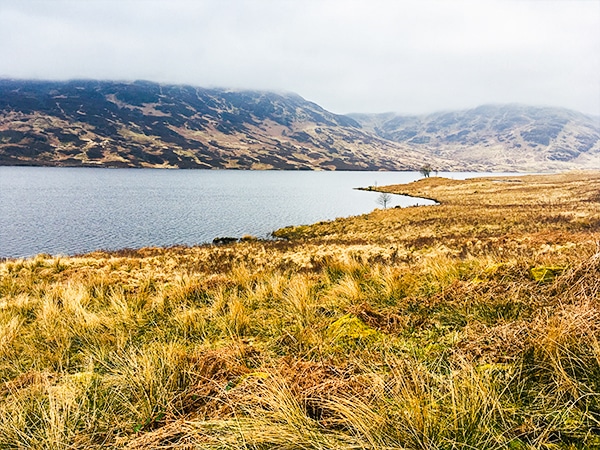
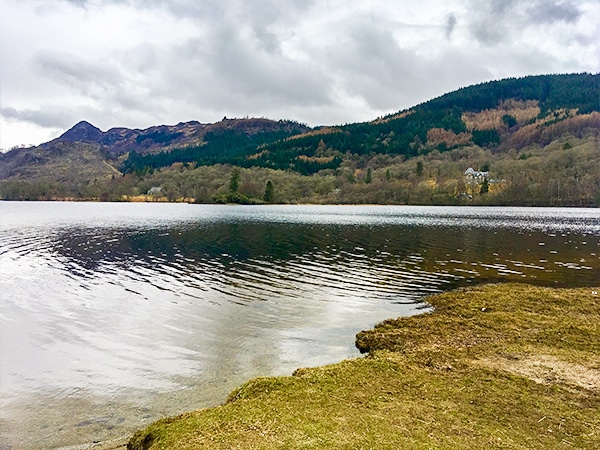
When to go to Loch Lomond
Spring, summer and early autumn are generally the best time to visit Loch Lomond & the Trossachs. The weather will be the warmest, the days significantly longer, and sunshine most abundant. The downside is you have to deal with bigger crowds. Also, even though it is summer, that doesn’t mean it won’t rain!
You can also visit Loch Lomond and the Trossachs during the off-season, though the weather can be cold and wet during the winter months and daylight short, but the crowds scarce. Confirm that your accommodations are open before setting off in winter, as some businesses have winter hours where they close early or don’t open at all.
How to get around Loch Lomond
The easiest way to get around Loch Lomond & the Trossachs is by car. If you’re flying in to do a good bit of hiking, we highly recommend renting a car, so you can drive directly to the trailheads and on your own time.
If you don’t want to drive, traveling by bus or train is still possible, but your options are much more limited. It won’t give you the same kind of freedom and flexibility and may not drop you off at all the trailheads you’re aiming for. We like the Traveline Scotland Journey Planner to help us use public transport.
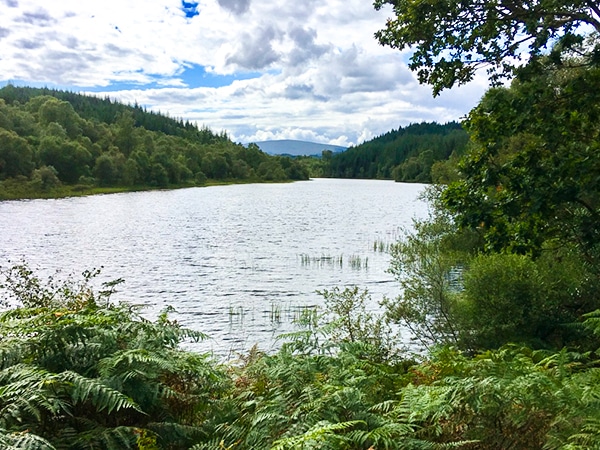
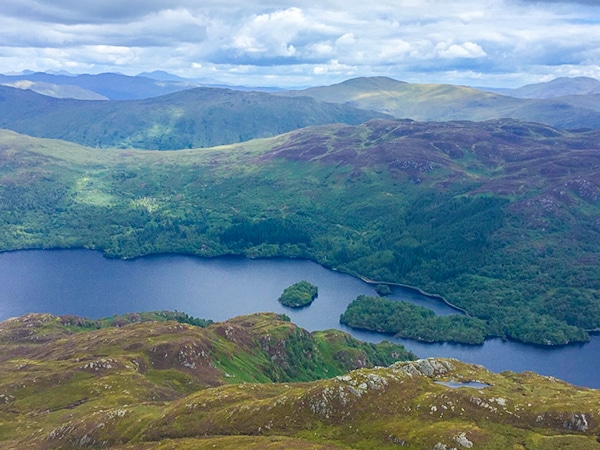
Where to stay in Loch Lomond
Whenever possible, we like to stay as close to the hiking as possible. This time, we chose two towns to serve as bases for exploring Loch Lomond: Balloch and Callander. Each town offers a variety of lodging options, delicious restaurants and easy access to hiking and other activities.
Balloch
Balloch is the main hub for most visitors to Loch Lomond & the Trossachs, and is one the largest towns in the area. Right on the edge of Loch Lomond, it’s served by direct rail from Glasgow, is easily accessible by car, and offers the most lodging and dining options of any town nearby. It’s just packed with BnB’s and cafes.
If you’re looking for a classy yet still affordable place to spend the night, you can try the Innkeeper’s Lodge in Balloch. It’s built around an 18th century pub, but offers modern, updated rooms with a local, cozy twist. There’s a bar downstairs with pub fare and a beer garden.
The Tullie Inn is much the same; updated and clean lodging in a traditional pub building, with eats and drinks downstairs and a short walk away from the lakeshore.
Another option might be the Norwood Guest House. Like the Innkeeper’s Lodge, it offers small, cozy but updated rooms in a traditional building, with easy access to all the cafes and pubs Balloch has to offer.
Callander
Callander is the other of the larger towns in the park, situated northeast of Balloch. Like Balloch, it offers all the lodging, food and entertainment you could want in your basecamp, while still allowing for easy access to the park and hikes.
If you’d like some luxury and the budget allows, you might enjoy staying in the Roman Camp Hotel. It’s in an elegant 17th century rural home on 20-acres of land, and makes it feel like you’re staying in a Scottish castle or country estate.
Callander Meadows is a BnB located in a 19th century townhouse, right off Main St. It’s more casual than the Roman Camp Hotel, but the rooms are cozy, and we like the restaurant and bar downstairs – the food is pretty good.
Finally, if you’re on a real budget and enjoy the social nature of a hostel, check out the Callander Hostel. You can bunk up in a dorm-style bed, or get your own private room for cheap and within walking distance to the rest of the town. There’s even a beer garden downstairs serving up pints to hikers and backpackers from all over.
Lochearnhead
The scenic village of Lochearnhead, sitting at the shores of Glen Ogle, is a quieter place for those who love a more peaceful getaway from it all. Even though it’s not one of the most popular destinations in the park, the village is one of the best hubs for walkers. Its perfect location allows for easy access to
Ben Vorlich, Glenample, Glenogle trail and the road to Glencoe and Oban.
In Lochearnhead, we recommend staying in Briar Luxury Cottages. These rustic and fully equipped cottages on the banks of Loch Earn are a great choice for those who want a private comfortable stay in one of the most scenic locations in the area.
What About Camping?
If the urge to camp is nagging at you, don’t fret, there are lots of camping options in Loch Lomond & the Trossachs National Park. There are dozens of campsites for tents and RV’s throughout the park – most of them reservable, but they tend to get crowded and fill up plenty in advance.
We prefer wild camping (dispersed camping). That’s one of the best things about this area actually – the ability to wild camp almost anywhere you want. Although technically Scotland does not have a “Right to Roam”, due to their great access rights, there is public access to most land provided this is exercised responsibly.
The Scottish Outdoor Access Code has some more defined rules, such as how many people can camp in one group, how many nights you may stay in each spot, and how far from structures you can be, to name a few. And between March and September, you must have a permit to stay in some designated Camping Management Zones. You can book these permits up to 8 weeks in advance and they are only £3 per tent.
Compared to backcountry camping in North American National Parks, “wild camping” is easy in Loch Lomond & the Trossachs. Respect the environment, other people and the rules, and then find yourself a beautiful and rugged place to pitch a tent and watch the sun go down over the loch.
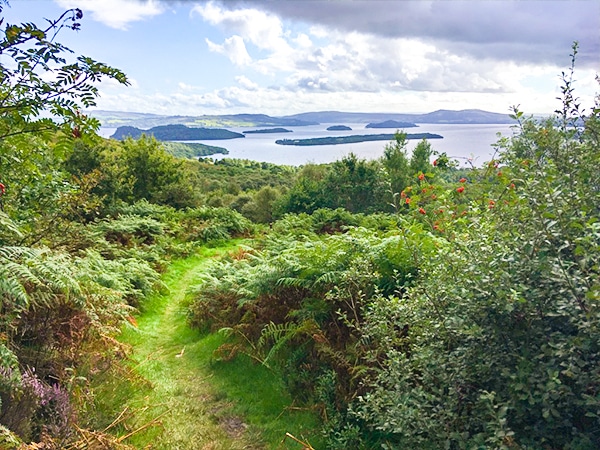

Where to Eat in Loch Lomond
Going for a meal in Loch Lomond & the Trossachs National Park can be a highlight of a trip to Scotland. While we are fans of hearty pub meals in cozy, historic pubs, you can also find international cuisine as well as some of the Scottish Classics, like fried Mars bars!
Balloch
Balloch has a good selection of small-town eateries and fancier restaurants. If you’re craving something savory, like Italian, head to Cucina. They serve up classic and contemporary Italian late into the night, ensuring you’ve got a place to go no matter how late you get back from the trail.
If, on the other hand, you’d like some comforting pub fare after a frigid walk in the park, head to the Balloch House. This traditional Scottish pub serves up your favorite pub grub and pints in front of a cozy fireplace. It is a welcome respite from Scotland’s wet and chilly weather.
For quick takeout, grab fish and chips from Lomond Fish Bar.
Callander
While restaurants and pubs dominate Balloch, Callander offers quite a few more casual options – like pizza and Chinese. We like Mimmo’s Pizza Parlor for a quick slice, as well as Puddingstone Place for a casual lunch (or a taste of haggis) before an afternoon hike.
For traditional Scottish British dishes in a sit-down environment, drive 10 minutes from Callander to Venachar Lochside. It’s right on the shores of Loch Venachar in a rural chic building, and you can order yourself a gourmet burger or grilled side of fish. It is one of the pricier restaurants, but we think it’s worth it. Book ahead as it can be very popular.
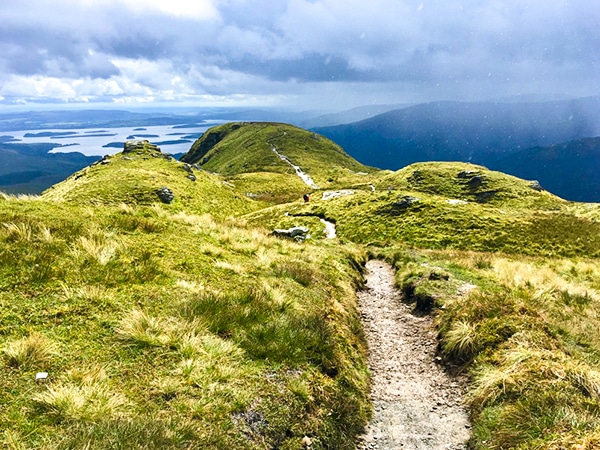
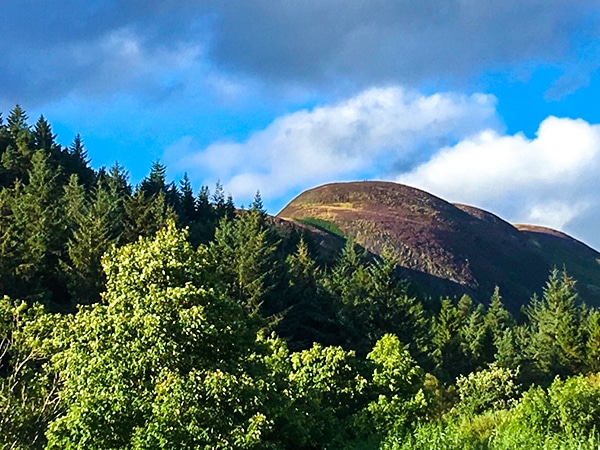
What Is There to Do in Loch Lomond & the Trossachs National Park?
There is tons to do here. Obviously, the walking is great, but that’s not all. With 22 lochs, there are nearly endless opportunities for canoeing and kayaking. Loch Lomond is huge, and you can easily spend days out there. Loch Lubnaig is open year-round for watersports, and is sheltered from high winds, making it ideal for beginning kayakers as well as paddle boarding and windsurfing. You could even hire an instructor to help you get started. Both Loch Lubnaig and Loch Lomond are easily accessed via car from either side, and you can rent paddleboards and kayaks from In Your Element in Balloch.
Like cycling? There’s plenty of that here, too – both mountain biking and road cycling. The West Loch Lomond cycle path offers 17.4mi of easy, clearly-marked cycling, starting from Balloch and winding along the shores of the loch, with views of Luss, Conic Hill and Munro Ben Lomond. It’s great for all ages and skill levels.
For adventurous and challenging mountain biking, try the Three Glens Route. It’s a 13.0mi loop that goes through three glens (hence the name) – climbing Glen Kendrum before quickly descending into Gleann Dubh and Glen Dochart. You could also try the Glen Loin Loop, an 11.2mi singletrack loop through the Arrochar Alps with some breathtaking mountain vistas.
To rent a bike from Balloch, head over to In Your Element. To rent one in Callander, try Wheelology.
Finally, if you’d like to take in the view from the loch but would rather relax, take a cruise. Cruises depart from Balloch, operated by Sweeney’s Cruise Company, as well as from many of the smaller towns on the lake, such as Luss and Inveruglas, which are offered by Cruise Loch Lomond.
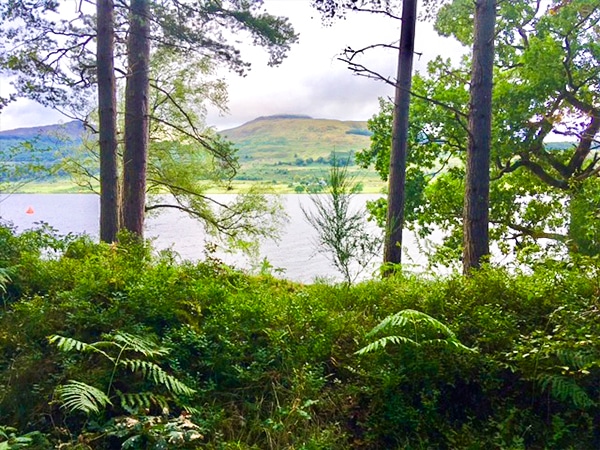
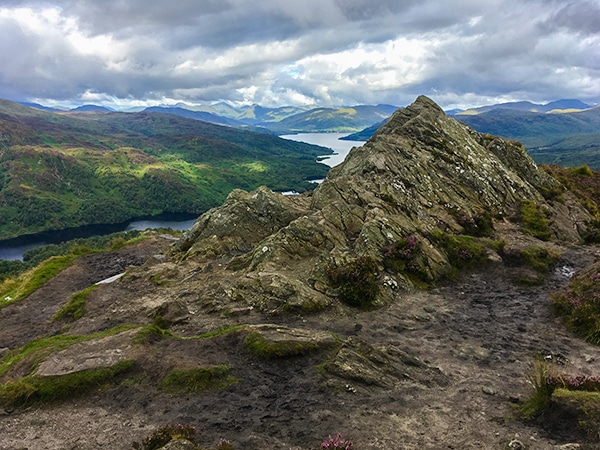
What Else to Know About Loch Lomond and the Trossachs
- Ticks can be found throughout the woodlands of the park and may carry Lyme Disease. Wear long sleeves and pants when hiking and camping, and use a good bug spray to keep them off.
- All birds and their eggs in the park are protected by law, and disturbing them – even making mock bird calls – is considered a punishable offence. Respect the wildlife!
- Farm animals and livestock – especially sheep – roam pastures throughout the park. Respect them and their owners, and if you bring a dog, keep him under control; don’t let them wander near the animals and spook them.
- The weather in Scotland is frequently cold, wet and gloomy – even in summer! It can also get quite windy up on mountaintops and on the lochs. As a seasoned adventurer you already know how important this is, but be sure to layer appropriately for the time of year you’re visiting and always bring a rain jacket.
Guide to Planning your UK Walking Holiday
Are you looking to experience the best walks in the UK? Have a look at these guides to the best walking in the UK
Articles on UK Trip Planning
- Lake District Camping Guide
- Planning your trip to the Chilterns
- Planning your trip to London, England
- Planning your trip the Lake District
- Planning your trip to Loch Lomond & the Trossachs
- Planning your trip to the Peak District
- Planning your trip to Snowdonia
- Planning your trip to the South Downs
- Winter Hiking in the Lake District


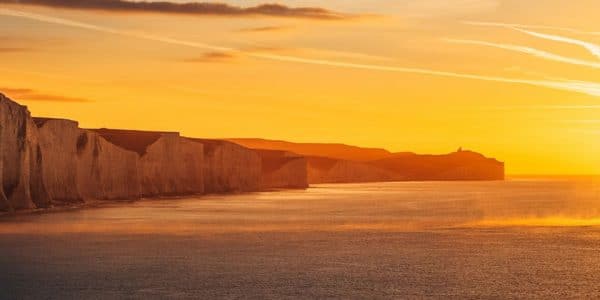
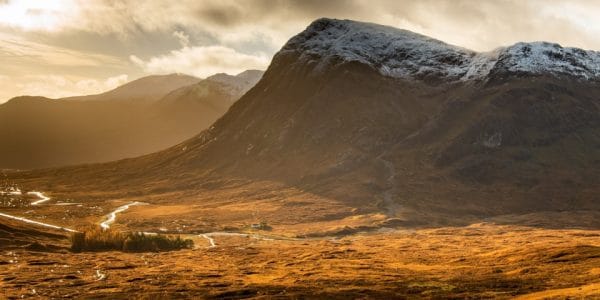
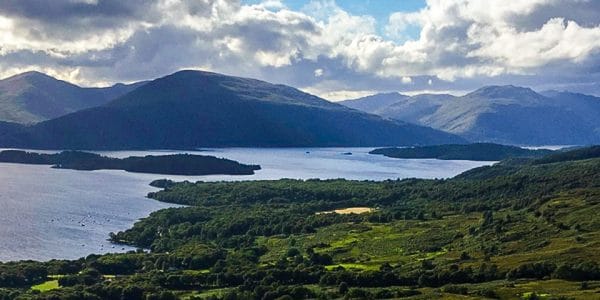
Comments
Madison6 years ago
Wow, I need to add this to my summer bucket list! Haggis and hiking?
ReplyRichard Campbell6 years ago
Start planning now, it can get busy on weekends in the summer.
Bobbie O6 years ago
don't tell anybody else about this park. it's terrible, don't come! jk,. it can get really busy on bank holidays though.
ReplyDavid Cameron6 years ago
Right to roam, that's a first. Not many blogs write about this. This would be great news for campers. And thanks for the heads up on what else we need to know about. Good article!
Reply